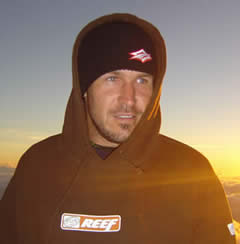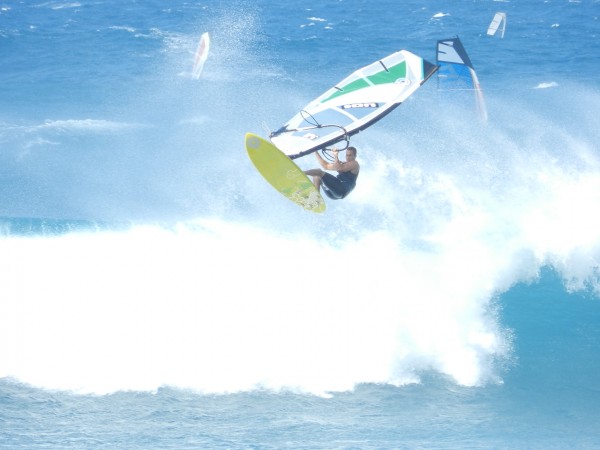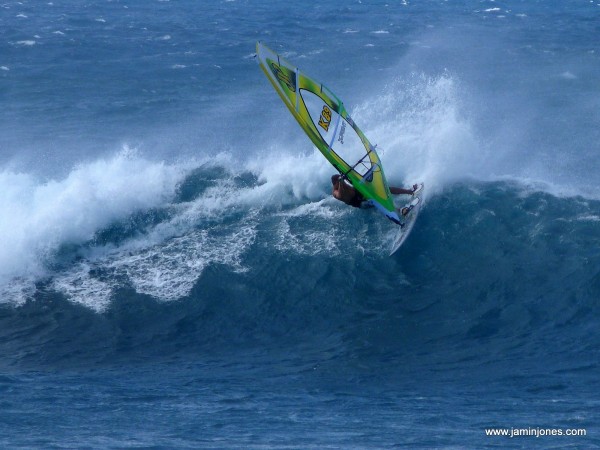Maui is the most synonymous location with windsurfing. Home to Hookipa, the most photographed windsurfing beach in the world. Home to many of the world’s top professional sailors, at least for some of the year, and the birthplace of many of the windsurfing industry’s manufacturers. Maui is windsurfing’s Mecca and it is a long way from the shores of the UK. It is perhaps the distance and the mystique that can put some people off.
Jan Sleigh took his first ever trip to Maui this summer, and with the help of Maui regulars, Clyde Waite and James Cox, they present the most comprehensive guide to Maui since windsurfing began!
Maui is NOT just a hard core location. There are so many beaches that offer anything from flat water to mast high waves all in one day.
One other thing about Maui not normally considered is that there is more than one town. But if you are visiting for windsurfing then the two places that you will spend most of your time around will be Paia and Haiku. For your time in Maui the area around these two towns is likely to become your known universe.
Fact File
| Windy Season | Summer |
|---|---|
| Air Temp In Summer | 25 degrees centigrade |
| Average Wind Speed | Winter: 18-22 knots Summer: 20-25 knots |
| Flight Time (From UK) | 17 hours; Not visa if you stay for less than 3 months. |
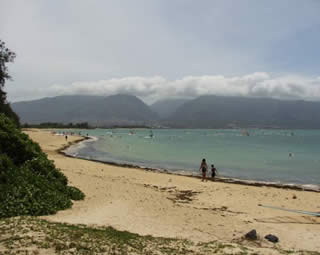
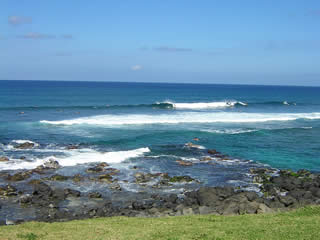
- How To Get There
-
If you would rather book a complete Maui package, get in touch with Sportif.
Fly
The only way to get to Maui is to fly. Several airlines operate flights to Maui but we asked the Maui seasoned UK professional windsurfers who they recommended and we were told United Airlines or American Airlines.
You will fly from Heathrow or Gatwick to the west coast of the USA (either San Francisco or Los Angeles) and then join a connecting flight to the island. The first flight takes 10 hours, the second takes 7 hours. The journey back home is a killer with two overnight flights. Jet lag will take several days to recover from. Be warned, this can wipe out most of the first week of a two week break.
United Airlines economy, no deal, flight price: Summer £600 – £800, Winter £500 to £700. Weekend flights are more expensive as are flights close to the 4th July and over the Christmas period.
http://www.hawaiian-holidays.co.uk
Note: Get ready for the Halfway to Hawaii game on all United flights. At this stage you will be exhausted and probably the only person on the plane not joining in.
(Maui airport code: OGG)
Taking your own kit
If you plan to take your windsurfing gear with you then excess baggage will be at the forefront of your mind. Excess baggage fees still remain a lottery depending on who you go with, how busy your flight is, whether you are taking up precious cargo space down below or whether the check-in girl has had an argument with her boyfriend and is in a particularly bad mood. But Jan Sleigh’s excess baggage experience was relatively straightforward with American Airlines.
However on your return, the airport staff at Kahului are very used to excessive amounts of windsurf kit and you will be charged a minimum of $180. If you’re unlucky, it could cost up to $350 to get your kit home. Top tip: get there early. You can check your entire luggage in and then go back to Paia (15mins down the road) for your last fish burger before boarding the flight.
Hiring a Car
You DO need a car in Maui, period.
There are several options, hiring newer cars and vans or hiring used cars from Word of Mouth or Good Karma. Don’t expect them to be over happy to see you though, which is an odd thing since they make most of there money from travelling windsurfers.
Al West Maui Vans: A huge white windsurfing van, sitting two people cost $1600 (approx £1200) for a month with full insurance in 2004. Their daily rate with no extras is $31. [email protected]
Word of Mouth is in Kahului but they will pick you up from the airport. Lots of windsurfers use them and they are used to providing you with roof racks. www.maui.net/~word/ or email [email protected]
Maui Cruisers: www.mauicruisers.net/
Maui Car Rentals: www.mauicarrentals.net/
Maui Sports Company: www.mauisports.com/transport/transport.htm
Good Karma Cars: Not too sure if this is still going but worth a try and will be a lot cheaper than Al West. [email protected]Buying a Car:
If you are planning to stay for a longer period of time then it might be worth buying a car. There are lots of wrecks available so you really need some car knowledge otherwise you’ll get stung. However, get a good run around, sell it 6 weeks later and you have saved yourself a lot of cash. Look in the Maui Bulletinwhich can be bought from any of the shops in Paia. (It comes out on a Thursday.)
However, on top of the price consider that you will have to register the car in your name which comes at a cost and you may have to renew the “safety sticker” which is their kind of MOT. However there are quite a few obliging garages that may give you an easy ride (you didn’t hear that here though).
You have to then register it in your name, which costs about 10 dollars, and if you have to tax it that will cost you about 90 dollars. You have to register the car at the equivalent of a post office in Kahalui, which is opposite Jack in the Box. It is not a quick job, you walk in, take a ticket and just wait, wait and wait. It is also advisable to get insurance. Mind you, I am sure that many do none of the above!
Taxi service from airport: Try Caroline Taxi – Tel: (808) 572 9915 – or sort out in the Arrivals Hall.
- How The Wind Works
-
Maui is blessed with the Trade Winds which are accelerated on the north shore by the geography of the Island. Mount Haleakala rises to over 10,000 feet and is the perfect shape for the wind to funnel around. The wind generally blows from the NE which gives starboard tack wave riding. The trades are less consistent in the winter time, but the swell is larger which is why you should head to Maui over the winter months if you want the waves. Occasionally, Maui experiences Kona winds. These winds are the result of a pressure system and blow from left to right. In Kona winds there are still places to windsurf but usually on the other tack (port).
- The Sailing Spots
-
Kanaha
Kanaha is the full deal! Flat water blasting, mellow waves and hardcore waves all in one session. There is a big flat water channel that takes you out to the open sea which is perfect for blasting and freestyle (although a little choppy when 4.7m weather and above). There are also plenty of sheltered areas in the bay which make learning ideal especially in the morning before the trades really kick in.
For wave riding there are two reefs: Upper Kanaha and Lower Kanaha, both of which can get big waves in large swells. Upper is probably the most challenging whereas the waves at Lower’s line up really well. Kanaha comes complete with grassy rigging areas, silver sands and plenty of parking. For these reasons it is usually the most crowded windsurfing spot on the island.
Kanaha is actually quite a distance away from the other windsurfing breaks, it involves a drive into Kahalui and then driving through the airport, before taking a right turn to the beach. It also means that you will have to sit in the daily Hana Highway traffic jam on your return journey.
- Best wind direction: NE trades and Kona winds.
- Worst wind direction: All others.
- Tide: Small tidal range.
- What’s on the bottom?: Sand and then coral reef.
- Any hazards: Other sailors. It can get horrendously busy on the water with 7 sailors per wave and lots of near misses. Spiky things that fall from the trees over the rigging area will have you limping in agony to the waters edge. Top tip, wear some cheap flip flops and leave them on the sand.
- Other water users: Kite surfers, but mainly down wind at Lower Kanaha.
- Suitability/levels: Beginner to expert. Lighter wind days or the morning are more suitable for beginners.
- Wipeout factor: 4/10 Wipe out factor is pretty low in the summer as there are only small waves, slightly more chance of kit breakage in the bigger winter swells. But if you do break something it is a long way back with a bit of a rip towards the harbour mouth. However loads of people around to keep an eye on you.
Camp one
Camp one is probably the best spot for jumping on the island. You can rocket skywards several times on one run out in the cross onshore winds and small to medium ramps. However, it is only supposed to be for the use of the private home owners. You will get shooed off the beach unless you can blag that you are staying in one of the rented houses. The beach is accessed by a narrow path through the private homes and parking is limited. Good luck!
- Best wind direction: NE trades
- Worst wind direction: All others
- Tide: Small tidal range
- What’s on the bottom?: Sand then reef where the waves break.
- Any hazards: The locals if you don’t park appropriately! There are a lot of shallow areas at low tide, so beware of these or you might be a fin or two down.
- Other water users: Mainly windsurfers.
- Suitability/levels: Intermediate to expert.
- Wipeout factor: 3/10
Baby Beach
First right after the Paia Golf Course from the Hana Highway, then the first left leads you to Baby Beach. The rigging area on the left is a small patch of lush grass. The main problem with Baby Beach is the launch (oh, and then the landing). It involves carrying kit down a narrow path and then clambering down slippery rocks into the sea and body dragging out for a bit. Aside from that Baby Beach forms a really nice wave off the beach front good for jumping and wave riding. It is never that crowded and always worth checking out. The sea colours are amazing hence a lot of photo shoots are done here.
- Best wind direction: NE trades
- Worst wind direction: All others
- Tide: Small tidal range
- What’s on the bottom?: Sand, reef and rocks
- Any hazards: A couple of protruding rocks to the left as you come in are the main concern, other than that it is pretty OK as a wave break.
- Other water users: None
- Suitability/levels: If you are confident at water starting and gybing a small board, and can cope with the launch, you’ll be fine.
- Wipeout factor: 4/10 More likely to hurt yourself clambering out over the reef. Waves are never too big or punchy.
Baldwin Beach Park, Paia.
This is basically a tourist and surfing beach and windsurfing is NOT allowed. There are several peaks from the dumping beach break as you enter and a couple of reef breaks on the right. The surfing here is much less intimidating than Hookipa, and is popular because of this. Generally a nice place to start the day with a mellow surf. However, it will get blown out fairly easily once the trade wind kicks in.
Kuau
First right after the Kuau Plaza heading eastbound, down a lovely road with lovely houses and lovely palm trees! You’ll then find a path between two houses and some more coconut trees. If you look down slightly to the right, there is small channel of sand between the rocks that you can swim out to the deeper channel, past a line of rocks. This is the only way to get in, where you can then sail out towards the reef. Sailing directly out from the keyhole, waves break from your right which stretch all the way to Lanes. There is also a line of waves breaking to your left, so you have to sail out through the channel. The reef is actually about 25 metres out to sea. So tack upwind a few times and pick your wave. It starts to wall up quite quickly, with some chunky sections. It is really good for jumping, with some steep sections to hit.
- Best wind direction: NE trades and Kona SW winds
- Tide: Small tidal range
- What’s on the bottom?: Coral reef and rocks. When the tide is low it gets pretty shallow and there are certain areas upwind where rocks can break the surface
- Any hazards: Rocks at low tide, a bit of a swim to get back in, coupled with a slight rip. Normally very quiet, which means you will have to look out for yourself more. Shark breeding ground but don’t let that put you off the clean waves
- Other water users: None really
- Suitability/levels: Advanced to expert. You need to be pretty confident to get in and out and it is also quite a sucky wave. However it is a good place to go once you have warmed up at the mellower waves of Sprecks and Camp One
- Wipeout Factor: 6/10 You can push it hard and pay the consequences. If you mess up then your kit just ends up in the channel and is pretty easy to get to. Even though you will be sailing in front of the rocks, the channel prevents you from getting involved in them.
Lanes and Mama’s
Lanes and Mama’s lie next to Hookipa, but to the west. They are usually less crowded then Hookipa but offer excellent down-the-line sailing in powerful waves. If you do wipe out then you will end up in the deep water channel between the reef the wave breaks on and a ledge which lies parallel to the beach. Rather than the Hookipa boulder and cliff experience. To get out back to Lanes it is best to time the run out and avoid the sets, so make sure your chicken gybes are Kentucky.
- Best wind direction: NE trades (starboard) and SW Kona winds (port).
- Tide: Small tidal range.
- What’s on the bottom?: Coral reef.
- Any hazards: Heavy waves, sharks, whales, shallow coral reef, turtles… the whole lot really!
- Other water users: Surfers
- Suitability/levels: On small to medium sized swells, the waves at Lanes are more forgiving than Hookipa. But on a big swell they are very heavy. Getting in at Lanes is tricky due to the reef full of urchins. The trick is to line up for the tree in the middle of beach where there is a key hole, and a slightly better foothold. Most tack up from Hookipa.
- Wipeout factor: 8/10 Wipeouts can be painful to you and your kit but you are more likely to get washed into a deep water channel and rock ledge rather than the sharp boulders of Hookipa.
Jaws
Go to Maui in the winter and you must make the trek down the pineapple fields to the cliff top overlooking Jaws. Word soon gets around as to when it will break. (A guide is that Hookipa has to be mast high in the sets for Jaws to even begin to break)
It is a truly breathtaking sight especially when it is being surfed. Another memory from Maui which will be ingrained in your brain for the rest of your days.
Note: unless you have a substantial 4 wheel drive, DO NOT attempt to drive down. Park on the road and walk. It can be real muddy and flip flops are a disaster, you have been warned.
Kihei
When all else fails, there is usually wind at Kihei. Kihei is bump and jump (South swells are very rare), and it is often very windy because there is no wind obstruction. Sometimes it will get very shallow near to the beach, so be careful. If the forecast for trade winds is poor, then always bear Kihei in mind.
- Best wind direction: Works in NE trades as the wind gets bent around the mountain, but is probably best in Kona winds where the wind will blow from the left.
- Tide: Small tidal range.
- What’s on the bottom?: Sand, the odd rock.
- Any hazards: The wind is offshore in a NE. It is not the cleanest water on the island. Rumour has it that the sewage systems from the numerous hotels end up just offshore from Kihei.
- Other water users: Kite surfers, tourist boats, whales from November to March.
- Suitability/levels: When it’s trades, the wind is super offshore so you need to be confident at getting back to the beach in an offshore wind. Best to go somewhere else. Generally the water is flat/ choppy and is best for slalom, blasting, free riding and freestyle.
- Wipeout factor: No real hazards that are going to take you out.
Hookipa
The world’s most famous windsurfing beach hosts big and powerful waves that regularly catch out even the most seasoned local. It is a playground for down-the- line windsurfing and definitely a box that needs to be ticked.
- Beach faces: North
- Best wind direction: NE trades.
- Worst wind direction: Anything that is not NE or SW.
- Tide: Small tidal range of a couple of meters. At low tide the reef is especially shallow.
- What’s on the bottom?: Sharp reef.
- Any hazards: Apparently Hookipa translates into “hospitality”, which is odd. Hookipa beach itself is fairly big, but the launch is tiny with a punchy shore break. Then there are shallow reefs, sharp boulders, no wind on the inside, rips and of course, huge waves. Walk in the beach park really! It can also get horrendously busy with plenty of wipeouts due to collisions. Whatever you do, don’t get involved with Josh Angulo on the water!
- Other water users: Local surfers at Pavilions to the east of the bay where windsurfers never venture. The odd surfer on the main windsurf break although they should clear off once the wind really picks up.
- Suitability/levels: You have to be pretty confident to windsurf at Hookipa in attitude as well as skill. It is intimidating due to the powerful nature of the wave, the rocks that greet you at the end of your ride and the amount of really good windsurfers out. Pretty much everyone ends up on the rocks on their first outing. It is worth watching from the cliff top to try and suss the place before your first outing.
- Top Tip: Be rigged and ready to go on the water at exactly 11am. There will be you and Matt Pritchard out on the water (he’s always there early). The rest of the Pros rock up after lunch and then it’s time to go to Sprecks for some bump and jump to finish the day off.
- Wipeout factor: 10/10 Hookipa can be a number 12 as far as wipeouts go. Summer time sailing can be mellower in the smaller waves, but at the end of the day if you break something the launch is only a few meters wide so getting back can be an issue. It will then be time to get cosy with the rocks.
- Water State
-
In the autumn, winter and spring Maui is definitely a wave location with regular ocean swells breaking on the many reef breaks and shores of the island. In general (with the exception of the outer reefs) Hookipa will witness the bigger waves decreasing towards Kanaha. Kanaha still has some very nice waves for getting into though.
Summer time occasionally will have a small swell bringing the reefs to life, but in reality the water state is “flat”. Different beaches will have slightly different water states, for example Kanaha is “flatter” than Spreckesville (Sprecks). The reality is that the wind is strong in the summer and therefore flat means a variety of states of chop. Windblown swell forms small waves that may get to be a meter high at Sprecks and maybe over head at Hookipa.
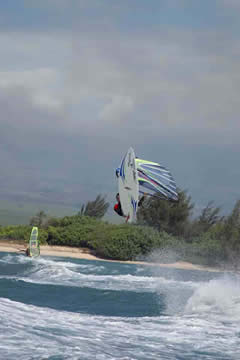
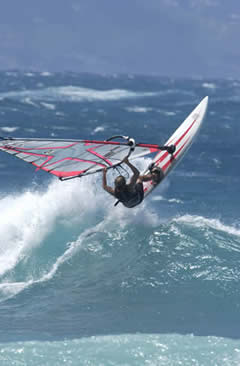
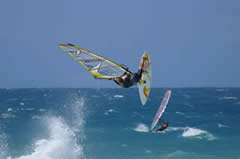
- Instruction And Kit Hire
-
Shops
Windsurfing lessons
Al West’s Lesson Center [email protected]
Alan Cadiz www.hstwindsurfing.com
Vela Windsurf www.velawindsurf.com
Maui Watersports www.mauiwatersports.com
Plus try all the shops above!
- Accommodation
-
You will need to stay around Paia or Haiku. Don’t stay in Kahului. Although 15 minutes from the beaches, it will be like living in a normal US town and nothing like the Hawaii experience you were after. Some sailors do stay at Kihei and sail mainly on the west side of the island or drive over to Paia every day (35mins, 50mins in traffic) but unless you’ve got a cheap place to stay, don’t bother. Stay on the North side.
Rainbows
Rainbows End Windsurf Hostel is quite a small homely place that is based in Paia. It has a bit of a hippy feel to it, but is generally OK for a few nights at least. It is quite communal with two big kitchens and a large common room. If you don’t keep the place tidy then you get fined, but not just you, the whole hostel so the pressure is on! The owners live below, so keep your head down. Prices are around $12 per night per person.
Email: [email protected]
Tel: 808 579 9057Kuau Plaza
This is probably the most popular accommodation for Maui first timers. You get an apartment which you can share with up to 4 other people. You can end up sharing bathrooms with strangers and some of the apartments are a bit tatty but it is in a perfect place located next to Mama’s Fish House and a 5 minute walk from Hookipa. Kuau is a popular Brit hangout and is about 80 dollars per week per person based on four sharing an apartment. However watch out for the spiders from the cane fields, they jump!
Fax no. (808) 579 8533 and address to Matt or Kenneth.
House Rentals
It is a good idea to try and sort out a private house or apartment if you plan to stay there for a while. However some can be really pricey. Check the links out in the information section below for ideas of where to stay. The general store in Paia will also have plenty of houses that are up for rent and failing that just ask around once you are there. It is often the best way!
Accommodation websites:
www.islandstylevacations.com
www.yasurfmaui.com
www.vacationrentals411.com
www.windsurfari.com
www.mauiaccommodations.com - Food
-
Eating out
Eating out is easy: Maui is an American state and America is the fast food capital of the world so you can get pretty much anything you want 24 hours a day. We’d recommend Jack In The Boxfor fast food. It’s cheap and is relatively healthy. The main Mall in Kahalui has a food hall with Chinese, pizza and burger outlets. For delicious food go to Jacques in Paia. It’s good value, real nice and Jacques is a cool dude and fast as hell on a windsurfer! The Fish Market in Paia is a good way to reward a really good session. It is pretty reasonable, and the food is so nice with delicious fish burgers. You queue up for your food and sit down at long tables wherever you can find a space. Good place to star watch.
There are also plenty of coffee shops in Paia for a quick boost before racing to the beach such as Anthony’s Coffee Company.
Casanova’s in Makawao serves typical Italian food and then turns into a nightclub later on.
For ultimate dining go to Mama’s Fish House near Hookipa. But you have to dress smart and it will cost you between $30-$50 per person for dinner.
Eating in
There are plenty of supermarkets in Kahului from K-Mart to Safeway. In general food is a tad more expensive than the mainland as they have to add shipping costs. If you are in a group then it is really worth purchasing a store card to use at the cash and carry, COSTCO. Safeway is fairly reasonable, but bread is expensive ($2-3 a loaf). In typically American fashion, it is cheaper to buy in bulk. To overcome the problem of storing all the bulk bought food, your apartment is guaranteed to have extra wide fridges and cupboards that even your pet elephant can fit in.
Mana Foods in Paia is possibly the ultimate health food shop although it does smell weird. You can get hot lunch here and although full of hippies, they all have credit cards to pay for the large bill you will get at check out.
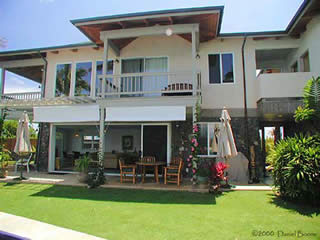
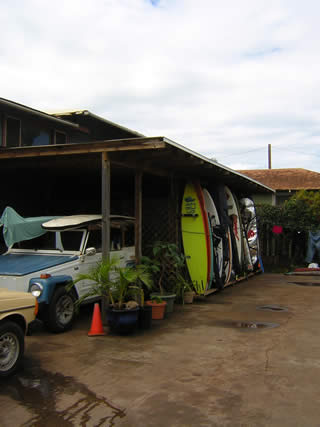
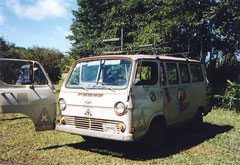
- Nightlife
-
The nightlife is pretty mellow on Maui. Most of the time is spent chilling with friends over a barbie or a DVD. The Sandbar in Paia is pretty laid back and shows surfing and windsurfing DVDs. Jacques and Charley’s are good places to hang out in Paia and get a beer. There is one nightclub that you should check out. It is up in the hills in a place called Makawao. The club is called Casanova’s, and is full of just that. During the winter, most Pro Windsurfers head there on a Wednesday night to peruse the local talent. Tipping is par for the course; so don’t forget to add a dollar onto your round.
The drinking age is 21 and unless you have grey hair and a walking stick, you will be asked for ID. This means the deadly combination of being drunk and having to carry around your passport all night.
- Bored Of Windsurfing
-
There is so much to do if it isn’t windy. You can surf, hike, mountain bike, kitesurf, shop or just hang out at the beach. The island caters for tourism so there are heaps of tours and attractions. Top 5 things to do would be:
1. Take a boat trip out to Molokini and snorkel off the reef then watch the whales on the way back (winter only).
2. Go and watch the sunset or sunrise on top of Mount Haleakala and then freewheel down it on a hired mountain bike. Note: It’s 10,000 feet up, take a jumper.
3. Take a trip to the Seven Sacred Pools on the Hana Highway then follow the road all the way round the rest of the Island.
4. Play golf. This is plenty of choice with Pukalani the best on the North Shore just before you get into Paia. The green fees here are between $45 and $55.
5. Take a trip to Lahaina, the “normal tourist” destination. Full of beaches, shops, golf courses and Yankee Doodle Dandees.
6. Money to burn? Then take a helicopter ride around the island. Costs from $80.
Hot Tips
OFF the WATER:
Cuts and Bruises:
Make sure you treat any cuts, whether from the reef or not. Staff is very prominent in Maui. A wound from one sailors foot strap (a product of going from boots to bare feet) got infected and he ended up with intravenous antibiotics and a course of drugs that lasted two weeks!
Phoning home & checking your mail
Go to a petrol station and buy a phone card for $10. This will give you 500 minutes of phone calls back to the UK! There are a few places in Paia where you can go on the internet. Just ask in any one of the shops or coffee houses.
If you have a phone line in your accommodation then you can pay a monthly fee (around $20) to connect to the internet via a free phone number. Speak to Maui.net in Kahului.[email protected]
People
In the winter, Maui is the show-case of the who’s who in windsurfing. If you are one of those types prone to become star struck, then heeling over and fainting, then Maui could be a very dangerous place to be. However, you should relish mingling and being inspired by the best in the world, and then being amazed as you watch them tame Hookipa from the hill top.
ON the WATER:
Rules of the road
Never sail before 11am, this is a time for surfers and fishermen. The wind does not always kick in properly till after midday anyway. Oh and drive on the right!
Give way
If you are new to the breaks, then there is no point getting into a shouting match. Give way, smile and think, heh, I’m in Maui! Normally the guy sailing out has right of way. When on a wave the guy on the wave/building swell first, has right of way. Dropping in and trying to sail over the back of a wave is generally a bad idea. They say Hookipa is always really busy, but in truth there a plenty of times during the day when it is quiet, just get there early!
Top Hookipa Tip!
The channel is a pretty safe place to be on a medium day as usually it just takes you out back. To the left of the channel (as you come in), is a very bad place to be swimming. The current takes you at rapid speeds onto the rocks. So, as wrong as this might feel, the best place to hit the section is right in front of the rocks, because if you go down then you will be in the channel before you know it. On big days the channel closes out, which can be unfortunate because just as you think you have got out – bang!!
Remember, you don’t have to sail at Hookipa! In fact, many of the other breaks are less crowded and are probably going to be more fun and more consistently windy than Hookipa.
Waterstarting
If sailing on the reef breaks, then try to water start as quickly as possible, with lots of sideways kicking of the legs. If you let your kit hang around in the water, then the currents can sometimes push the sail underwater, making it tricky to water start. Kicking hard is a bad thing as you might end up kicking the reef and cutting yourself, which might lead to disastrous infections.
Sharks
Fact: there are sharks in the sea.
Fact: there is approximately one attack per year on Maui.
Fact: it could be you!
- Conclusion
-
I only got to sail in Maui for 10 days of my 51 day trip because I crashed a push loop and injured my ankle so badly that it put me on crutches for two weeks and then off the water for the rest of my trip. But I had 10 days of amazing windsurfing and loved every second of it. So much so that I was planning next years trip only a few days after my accident. I can’t wait to get back! In the summer it is windy almost every day but not so wavy. The winter is a lot more variable as the trades are less consistent but you get to hang out with the stars and watch the Hawaiian swells in action. The choice is yours!
- Tourist
-
Name: Jan Sleigh
Local beach in the UK: Hayling Island
How many years sailing: 20
Last windsurf move you cracked: Push Loop
What you’re working on now: Everything!Jan is sponsored by: Naish Boards & Sails, Reef, Quiksilver and K172SurfShop.
